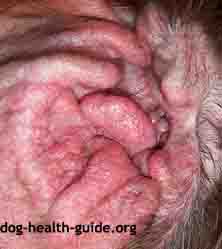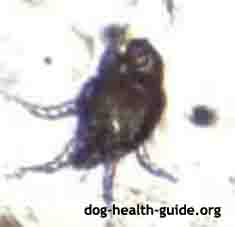How To Recognize and Treat Dog Ear Mites
Summary:
If your dog is scratching his or her ears, and shaking their head, then dog ear mites, a type of ecto-parasite, (otodectic dog mange or otitis externa) which is the second most common parasitic disease in dogs after fleas. It is often diagnosed in puppies, but can be a problem for dog's of any age.
Dogs with ear mites scratch their ears a lot, removing some of the hair in the process. It's a canine parasite skin infection that can strike year round. While this parasite affects the ears, the other type of mange, sarcoptic dog mange or dog scabies, can also effect the ear tips as well as other parts of the body.
The problem starts when mites enter and irritate the ear and ear canal while feeding on skin debris. The mites create debris causing the ears to appear dirty, containing wax or filled with coffee grounds. If the waxy exudate caused by the mites builds up, it can become a breeding ground for fungi and bacterial infection.
Mites can spread from dog to dog and unlike other types, do not burrow into the skin. The mites take 3 weeks to mature from egg to adult can survive in a dog ear for several weeks. While the dog ear mites primarily inhabit the ears, they can also be found at the head of the tail, on the neck, face and feet.
Inflammation Caused By Dog Ear Mites
Source: Olathe Animal Hospital
Overview
Ear mites are commonly caused by the mite Otodectes cynotis. They are visible to the human eye and look like small white spots that move. The most common symptom is scratching at the ears, but they can live on other parts of the body and in the dog's environment. Another sign are ears that small badly caused by dried blood residue. Ear mites are spread when a dog is either outside from a mite that is on the ground or when in close contact with another animal.
A single female mite lays five eggs a day. The mites can hatch in four days and then immediately start feeding on the oils and wax found in the ears. The mite goes through 5 developmental stages and will live for about 2 months.
Treatment involves a thorough ear cleaning and the application of a medication to kill any remaining mites. If the mites caused an infection, then antibiotics are prescribed. The veterinarian might recommend a series of baths over the course of a month to ensure that any mites are removed from the dog's coat.
Left untreated the mites can cause problems with balance and hearing loss. If you see any symptoms consult with your veterinarian.
Dog Ear Mite (Otodectes Cynotis) Under a Microscope. It is a Non-burrowing Mite.
Source: Dr. Chris Adolph, Southpark Veterinary Hospital
Symptoms
Symptoms of dog ear mites include:
- Mild Cases:
- itch
- scratching the ears
- head shaking
- reddish ear irritation
- crust or wax formation and discharge in the ears
- hair loss around the ears or a blood blister (aural hematoma) from scratching
- Severe Cases:
- smelly discharge (purulent)
- bleeding in the ear
- a perforation of the tympanic membrane
- inflammation of the middle ear (Otitis media)
- vomiting and vertigo (otitis interna)
- movement problems in the neck (jerking of the neck)
Diagnosis
A veterinarian will look in the ear with a device called an otoscope or will examine dog ear wax under the microscope and will be able to identify the presence of mites. Some dogs may need to be sedated prior to an ear exam if the ears are very irritated.
Other conditions may causes similar symptoms, and should be ruled out.
Treatment
For canine ear mites your veterinarian will first clean the ears with a product like EpiOtic Ear Cleaner. Medications are then applied in one to two treatments to the ear canal. Ear drops contain a miticide with popular brands called Acarexx (an invermectin .01% based mitcide) or MilbeMite OTIC (.1% solution of milbemycin oxime), or Oridermyl®. The drops may need to be used 1x to 2x.
Revolution (Selamectin), Advantage Multi®, or Milbemite® is then applied twice at 30 day intervals to protect against any mites (Revolution is is a spot-on for dogs older than 6 weeks of age only). If there are signs of a bacterial or fungal infection in the ears, medications will be prescribed to treat these conditions as well.
Medications do not kill mite eggs. Any treatment will target the larval and adult mites.
The veterinarian may ask for a return visit to confirm that all mites have been eliminated.
There is also a herbal remedy called Ear Dr. that can help with the symptoms of ear discomfort such as itch and pain.
Because mites can be passed between dogs, all pets in the household will need to be treated as a precaution. Mites can live in the environment for up to 12 days. Treatment is important to avoid long term damage to the ear. If your dog has ear mites, be sure to clean the dogs environment with a disinfectant such as Benzarid, by thoroughly vacuuming the home, and by washing all of a dogs belongings with a liquid detergent.
It is rare for dog mites to cause symptoms in humans. Removing the mites from your pet and the environment will eliminate any symptoms on humans.
FAQ
How can you tell if your dog has ear mites?
Dogs with ear mites will exhibit two primary symptoms, scratching at the ears and the presence of crust or waxy discharge. You can also notice a strong odor from the ears.
How do you get rid of ear mites in dogs?
Ear mites in dogs are treated by a veterinarian. Treatment starts with a thorough ear cleaning, followed by the use of a topical or injected miticide. The dog's environment will also need to be cleaned.
What causes ear mites in dogs?
Ear mites in dogs are caused when a dog comes in contact with another infected pet, or they can be contracted from the environment.
Can humans get ear mites from dogs?
It is very rare for humans to contract ear mites from dogs. Treating the dog will solve any issues with humans.
What happens if dog ear mites are left untreated?
Untreated dog ear mites can result in hearing loss and a loss of balance.
Have A Dog Parasite Question For Our Vet? We'll Answer It For Free!
Do you have a Dog Parasite related Question for our Veterinarian or a Helpful Story to Share? Please include information such as dog age, sex, breed, medical history, medications your dog is taking, recent changes in behavior, outdoor/indoor lifesytle, behavior etc. Pictures are also helpful in identifying the severity and cause of any parasite related problems.
We will do our best to get back to you quickly (depends on how many questions we receive each day). If you do require an immediate response we suggest using this online dog veterinary service that is available now for a small fee.
References
External Parasitic Diseases of Dogs and Cats
Payne P.A., Dryden M.W. and Carter C.R.
Concise Guide to Infectious and Parasitic Diseases of Dogs and Cats
VCA Hospitals, Malcolm Weir, DVM, Msc, MPH; Ernest Ward, DVM


